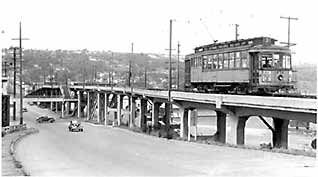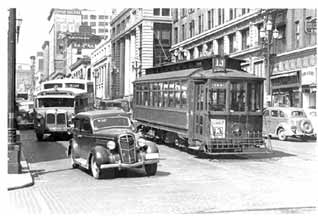


When I visited Warren Wing at his home, he pulled out a conductor's cap and a swung a coal oil lantern, which had once lit the way of an Interurban railway car, as it sped through the night from Seattle to Tacoma, Everett, or another destination. The author of several books on local public transit history, Warren remembers riding the streetcars to high school in Seattle, back in the 1930s. The following is a summary of some of the information, which Warren and his friend Noel Holley generously shared with me.
The old Seattle streetcars ran until 1941. The last one in operation was in Ballard. It ran along 8th Avenue Northwest. In their heyday, there were thirty different streetcar lines in the city. One line ran to Alki, another to West Seattle, another to Greenlake, one ran through Ravenna park, and so on. The streetcar routes were spaced throughout the city, which at that time stretched from North 85th St. down south to approximately Boeing Field. A separate system, the Interurban Railway, connected Seattle to nearby cities, including Tacoma, Everett, Renton, Bellingham and Mount Vernon.
The Seattle streetcars were powered by electricity, and originally owned by the Puget Power Company. The tracks generally ran right down the middle of the street, above ground. The cars came frequently, every five to ten minutes, and were noisy, but fairly reliable.
Each car had a staff of two, a conductor and a motorman. Cable cars clanged up Yesler, Madison and James streets. Queen Anne Hill was climbed by streetcars, which were helped by a counterbalance. The counterbalance went down, while the streetcar went up, to provide a pulley effect. At the summit of Queen Anne today, the only reminder of this history apparent to the casual observer is the Counterbalance Barber Shop.
In 1940 and 1941, the cablecar and streetcar systems were completely dismantled. Tracks were ripped up, and the cars which were made primarily of wood, were burned, leaving behind their metal skeletons which were salvaged for scrap. Why did this occur? Those who have seen the movie, Taken for a Ride, are familiar with the story of the streetcar systems in Los Angeles and various other cities, which were bought up by a dummy company (actually a front for General Motors, Standard Oil, and Firestone Tire), and then destroyed deliberately, in order to make room for cars and buses. Was this what happened in Seattle? "No", said Warren, "The story in Seattle was different." Puget Power was losing money on the streetcar system, and sold it to the city of Seattle in 1919, when Ole Hanson was mayor. The city paid a high price for the system, and assumed a debt of millions of dollars. When the Great Depression hit, the city could not afford to pay its creditors, in spite of a bailout loan, which was eventually provided by the Roosevelt Reconstruction Finance Corporation.

|
| Accidents sometimes happen! Seattle's light rail operated on overhead electricital lines, like many of the buses now, but used the center lanes of the streets. |

|
| Eastbound Spokane Street Viaduct at 24th SW (Younstown) August 1940, not long before the system was dismantled |

|
| Overtaken by the car. second Avenue and James Street downtown, April 1938 |
The streetcars continued to lose money, and their demise was hastened by competition from unregulated jitney cabs and buses. At some point a decision was made to replace the streetcars with trackless trolleys, which were essentially buses hooked to overhead wires.
As I looked at the old photographs which Warren showed me, of streetcars plying their way over the muddy or dusty streets of the young city, I was struck by the picture of two men, the conductor and the motorman, standing by their streetcar, looking proud and happy.
I wondered whether modern public transit is losing too much of the human element, in the drive to achieve maximum efficiency, and cut costs. When I was a kid, riding the public bus to junior high school in California, there were times when I would have been grateful for two drivers, one to drive the bus, and the other to discipline the tough kids who periodically harassed me. Could the bus which plunged over the Aurora bridge have been saved if a second Metro driver had been on board? We will never know.
Certainly, employing people to provide friendly help to the public on buses and trains seems more worthwhile than employing them to staff prisons or build weapons. It's true that the streetcars in Seattle were expensive to run, in part because of high labor costs, but with our future light-rail trains and possibly monorails, we should think about keeping real human beings in the system.
|
Home
|
Subscribe
|
Back Issues
|
The Organization
Volunteer | Do Something Directory | Activist Calendar Back to this issue's directory |